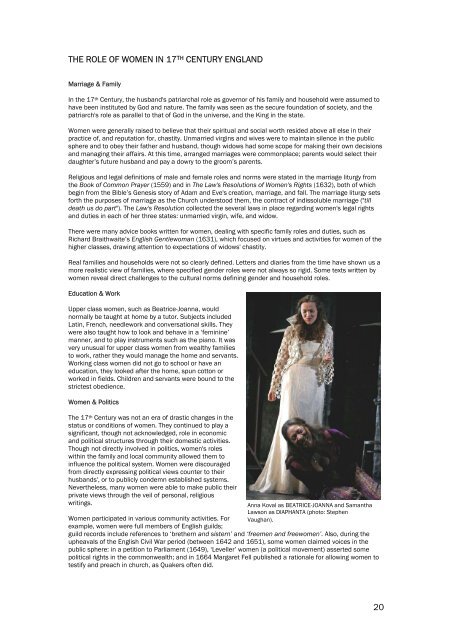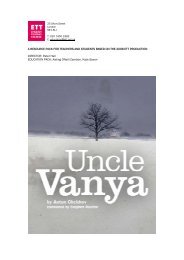Download The Changeling Education Pack - English Touring Theatre
Download The Changeling Education Pack - English Touring Theatre
Download The Changeling Education Pack - English Touring Theatre
Create successful ePaper yourself
Turn your PDF publications into a flip-book with our unique Google optimized e-Paper software.
THE ROLE OF WOMEN IN 17 TH CENTURY ENGLAND<br />
Marriage & Family<br />
In the 17 th Century, the husband's patriarchal role as governor of his family and household were assumed to<br />
have been instituted by God and nature. <strong>The</strong> family was seen as the secure foundation of society, and the<br />
patriarch's role as parallel to that of God in the universe, and the King in the state.<br />
Women were generally raised to believe that their spiritual and social worth resided above all else in their<br />
practice of, and reputation for, chastity. Unmarried virgins and wives were to maintain silence in the public<br />
sphere and to obey their father and husband, though widows had some scope for making their own decisions<br />
and managing their affairs. At this time, arranged marriages were commonplace; parents would select their<br />
daughter’s future husband and pay a dowry to the groom’s parents.<br />
Religious and legal definitions of male and female roles and norms were stated in the marriage liturgy from<br />
the Book of Common Prayer (1559) and in <strong>The</strong> Law's Resolutions of Women's Rights (1632), both of which<br />
begin from the Bible’s Genesis story of Adam and Eve's creation, marriage, and fall. <strong>The</strong> marriage liturgy sets<br />
forth the purposes of marriage as the Church understood them, the contract of indissoluble marriage ("till<br />
death us do part"). <strong>The</strong> Law's Resolution collected the several laws in place regarding women's legal rights<br />
and duties in each of her three states: unmarried virgin, wife, and widow.<br />
<strong>The</strong>re were many advice books written for women, dealing with specific family roles and duties, such as<br />
Richard Braithwaite’s <strong>English</strong> Gentlewoman (1631), which focused on virtues and activities for women of the<br />
higher classes, drawing attention to expectations of widows' chastity.<br />
Real families and households were not so clearly defined. Letters and diaries from the time have shown us a<br />
more realistic view of families, where specified gender roles were not always so rigid. Some texts written by<br />
women reveal direct challenges to the cultural norms defining gender and household roles.<br />
<strong>Education</strong> & Work<br />
Upper class women, such as Beatrice-Joanna, would<br />
normally be taught at home by a tutor. Subjects included<br />
Latin, French, needlework and conversational skills. <strong>The</strong>y<br />
were also taught how to look and behave in a ‘feminine’<br />
manner, and to play instruments such as the piano. It was<br />
very unusual for upper class women from wealthy families<br />
to work, rather they would manage the home and servants.<br />
Working class women did not go to school or have an<br />
education, they looked after the home, spun cotton or<br />
worked in fields. Children and servants were bound to the<br />
strictest obedience.<br />
Women & Politics<br />
<strong>The</strong> 17 th Century was not an era of drastic changes in the<br />
status or conditions of women. <strong>The</strong>y continued to play a<br />
significant, though not acknowledged, role in economic<br />
and political structures through their domestic activities.<br />
Though not directly involved in politics, women's roles<br />
within the family and local community allowed them to<br />
influence the political system. Women were discouraged<br />
from directly expressing political views counter to their<br />
husbands', or to publicly condemn established systems.<br />
Nevertheless, many women were able to make public their<br />
private views through the veil of personal, religious<br />
writings.<br />
Women participated in various community activities. For<br />
example, women were full members of <strong>English</strong> guilds;<br />
Anna Koval as BEATRICE-JOANNA and Samantha<br />
Lawson as DIAPHANTA (photo: Stephen<br />
Vaughan).<br />
guild records include references to ‘brethern and sistern’ and ‘freemen and freewomen’. Also, during the<br />
upheavals of the <strong>English</strong> Civil War period (between 1642 and 1651), some women claimed voices in the<br />
public sphere: in a petition to Parliament (1649), ‘Leveller’ women (a political movement) asserted some<br />
political rights in the commonwealth; and in 1664 Margaret Fell published a rationale for allowing women to<br />
testify and preach in church, as Quakers often did.<br />
20





